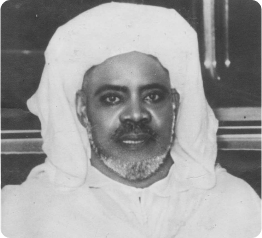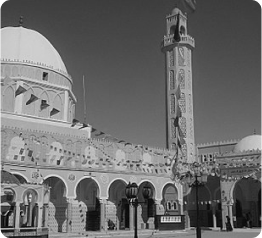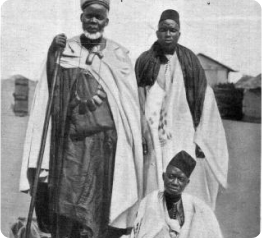Shaykh Ibrahim Niasse
The following biography is based on “Shaykh Ibrahim Niasse: Revivalist of the Sunnah,” a paper presented by Shaykh Hassan Cisse to a Northwestern University conference on Muslim Scholars in Africa (1984).
Shaykh Ibrahim Niasse (1900-1975) was West Africa’s most renowned Islamic scholar in the twentieth century. His followers numbered in the millions and comprised the largest single Muslim movement in West Africa (Hiskett, 1984). He was also well-known among the ulama and leaders of the broader Muslim world and a member of such organizations as the Muslim World League (Rabitat al-‘Alam al-Islami based in Saudi Arabia, of which he served as Vice President), the World Muslim Congress (Mutamar al-‘Alam al-Islami; Karachi, Pakistan), the Islamic Research Assembly (Majma’ al-Buhuth al-Islamiyya; Egypt) and the High Council of Islamic Affairs (Majlis al-‘Ala li al-Shu’un al-Islamiyya; Egypt). Following a trip to Cairo, Egypt, in 1961, he became widely known as “Shaykh al-Islam” after having led the Friday prayers in the prestigious Azhar mosque.
Shaykh Ibrahim also maintained close relations with several prominent leaders in the independence movements during the 1960s, such as Kwame Nkrumah (Ghana), Ahmad Sekou Touré (Guinea) and Gamal Abd al-Nasser (Egypt). He campaigned tirelessly for governments to respect the rights of Muslims and the oppressed world-wide. He spoke out on several international causes, such as Israeli aggression toward the Palestinians, but he was also interested in interfaith issues and maintained good relations with Vatican representatives. He also became involved in social concerns, stressing racial equality and the rights of women. In regards to the latter, the Shaykh encouraged women to “compete with men in knowledge.”
Shaykh Ibrahim Abdullah Niasse was born in rural Senegal, the son al-Hajj Abdoulaye Muhammad Niasse. Al-Hajj Abdoulaye (d. 1922) represented the culmination of a long line of Islamic scholars in the Senegambia region, and was himself a well-traveled and consummate shaykh, attracting students from all around the region as far away as Mauritania. Shaykh Ibrahim was educated primarily at the hands of his father, with full access to his father’s extensive library. Shaykh Ibrahim mastered at an early age the full range of Islamic sciences: the Qur’an and its interpretation, the Hadith and their explanation, jurisprudence and Sufism.
In reference to his educational background and achievements, Shaykh Ibrahim said, “I learned Qur’an and Hadith first from my shaykh, my father, and he, from his father. I received an ‘ijaza (diploma from the majalis al-‘ilm) first from my father in both Qur’an and Hadith, then from Abdur-Rahman b. alHajj-1-‘Alawi (Mauritania) and another ‘ijaza from Shaykh Ahmad Sukayrij (Morocco) who himself had earned some six hundred ‘ijazas from six hundred different shaykhs whose names are mentioned in his book, where he writes, ‘The first one to whom I gave authorization in all these chains of transmission was the Khalifa al-Hajj Ibrahim Niasse.'” Shaykh Ibrahim once said concerning his scholarly credentials: “What I have in the way of ‘ijaza and muqaddam authorizations would indeed fill a book.”
As for the content of his teaching, it was nothing more or less than the Qur’an and the Sunnah of the Prophet Muhammad and its revitalization. Throughout his life, the example of the Prophet was his means and end. Shaykh Ibrahim used to say, “If the best of mankind, the Prophet is moving, even I shall follow him step by step; and the day he stops from there I shall never move.” Elsewhere in a poem, Shaykh Ibrahim wrote, “If I am asked, what is your madhhab (school of jurisprudence) and who is your beloved, I can answer that it is the Prophet, and none other.”
Shaykh Ibrahim was the best example of a Sufi according to the description “The Sufi is the son of his hour (ibn waqtihi).” He will respond to the needs of the time. At every moment he is dealing with the requirements of that moment. The Muslim who is greatest in understanding is he who submits to the rule of his hour. That is, he gives everything the position it requires in action and speech. He is a person moving with time in a circle. He does not attempt to stop time, not to become stagnant in it, nor to regress in it. His effort is aimed at continually moving forward. In the season of Ramadan he reads Qur’an and Hadith and presents their explanations. In the season of Hajj, he expounds the virtues of the Muslim pilgrimage. At the time of Mawlid, he recites the Prophet’s Sira or Biography.
All of this behavior characterized the Sufism of Shaykh Ibrahim. It was based on action and practice, traveling all over the Muslim world, giving speeches, writing pamphlets. In every endeavor, his goal was to direct Muslims to the right path (siratul mustaqim). Sickness did not bother him unless it halted his activity in behalf of spreading Islam. Indeed, his tasawwuf was not characterized by heedlessness and neglect (ghafla). It was based on real Islam, mastering the self (nafs) and ruling over it with Qur’an and Sunnah. His Sufism was producing and working in various fields of life on the farms, and so forth.
In a speech in the 1960s, Shaykh Ibrahim addressed a group of Muslim youth and said, “For the youth, I thank you all for your papers. And I am here to tell you to go ahead and be in the vanguard of things. Surely the future of every nation is based on its youth. But it is not based upon all of them, not upon every individual, but only on the intellectual ones, the educated ones with good character, good manners, and zeal. As for the youth lacking education and good character, he is like a seed unfertilized. So make every effort to seek and do your best to acquire more knowledge, not only Islamic knowledge, not only mathematics and its branches, but also be part of and cooperate with those whose zeal is to discover the unknown and unseen things of this world.”
Throughout his life, Shaykh Ibrahim’s character was based on the Qur’an and the Sunnah of the Prophet, a fact verified by prominent Muslim leaders who knew him. For example, we note in the letter of Shaykh Muhammad al‑Hafiz al‑Tijani – the Egyptian who was known as the foremost man of Hadith in his age – the words:
“Praise belongs to Allah, after Allah has blessed us by binding us in love: this humble servant Muhammad al-Hafiz al-Tijani and the Hujja, the cornerstone of the religion, the sea of confidence, the believer in Allah, my brother and the brother of my spirit, my master Abi Ishaq, Shaykh Ibrahim…”
In his greeting, it is important to note that Shaykh al-Hafiz uses the word Hujja, or “the proof”, as a form of address. The scholars of hadith have ranked the scholars who work in this field. Each rank has a specific name. For example, the muhaddith is the narrator of hadith who reads traditions based upon narration and report. The hafiz has memorized hadith to the number of one hundred thousand along with their explanation. But the Hujja has memorized three hundred thousand hadith with their explanations and chains of transmission from the Prophet. Likewise, a 1961 letter from the Secretary General of the Muslim World League in Mecca, the late Shaykh Muhammad Surui Al‑Sabban, addresses Shaykh Ibrahim as follows:
“The Owner of Virtue, The Member of the Islamic Conference, Brother Shaykh Ibrahim Niasse well‑respected, Assalamu Alaikum. Peace be upon you, and the mercy of Allah, and His Blessing be upon you. The pioneers have left the Hijaz, along with the propagators of the religion. They also left with the jurisprudence/understanding (fiqh) of the Hijaz, and now it remains with you, Shaykh Ibrahim. The old style of reading the Qur’an has also left the Hijaz, but you have remained reading the word of Allah with this same style of Hijaz, the style of Nafi Mawla Abi Nu’aym. Indeed, you are of the real people of Medina in both Fiqh and Qur’an. These are the proofs of your steadfastness, and it is not the pride from within me, but the pride is for you and by Him. You have believed and steadfastly you have protected and spread the religion and become victorious.”




